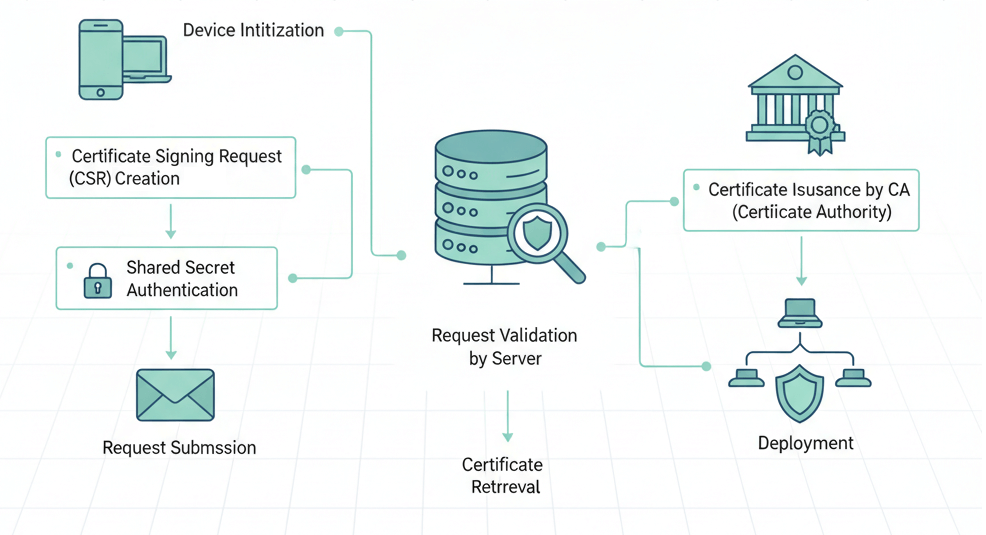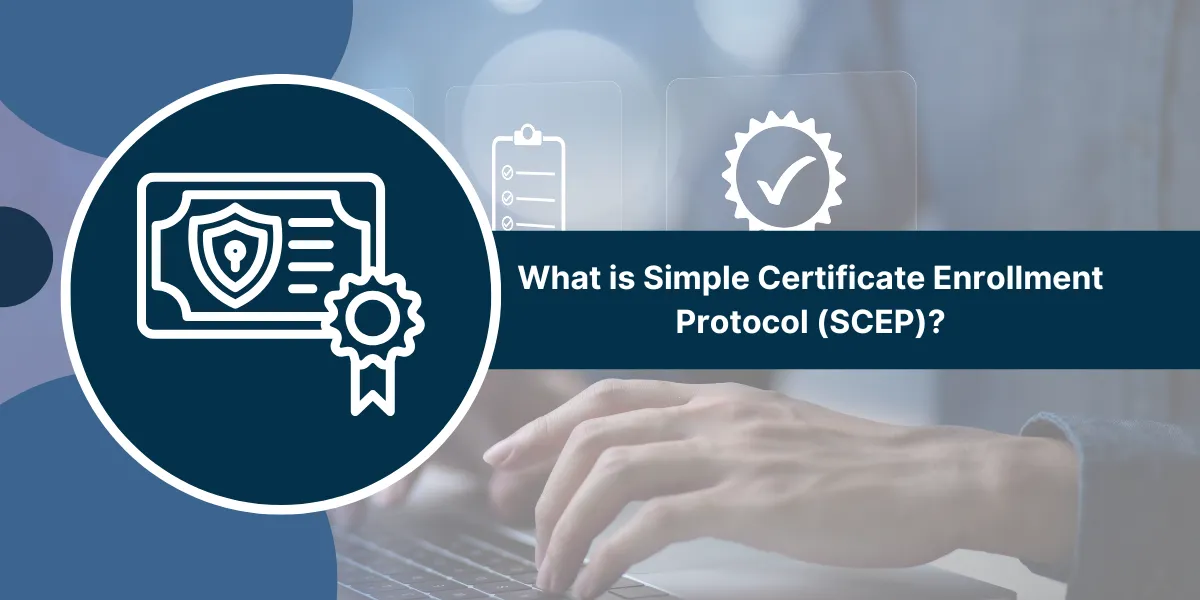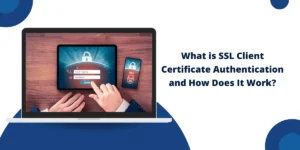The Simple Certificate Enrollment Protocol (SCEP) operates as a standard method which automates digital certificate management certificate authorities. The SCEP protocol enables secure communication through automatic Public Key Infrastructure (PKI) certificates for network devices. The protocol system manages certificate requests and renewals and distribution operations between network devices and management for enterprise networks and mobile devices.
How Does Simple Certificate Enrollment Protocol (SCEP) Work?
The following explanation shows how Simple Certificate Enrollment Protocol (SCEP) functions through sequential steps.

- Device Initialization: The device (client) begins its process by creating RSA cryptographic key pairs for initialization.
- Certificate Signing Request (CSR) Creation: The device produces a PKCS#10 formatted Certificate Signing Request (CSR) which includes both public key information and device identification details.
- Shared Secret Authentication: The SCEP server verifies the device’s authenticity through its shared secret authentication process which uses either a password or challenge.
- Request Submission: The SCEP server receives the CSR along with the shared secret through HTTP or HTTPS connections.
- Request Validation by Server: The SCEP server checks the shared secret authentication and verifies the Certificate Signing Request (CSR) before proceeding.
- Certificate Issuance by CA: The SCEP server sends the request to the Certificate Authority (CA) which generates a signed certificate before returning it to the server.
- Certificate Retrieval: The device checks the server at scheduled intervals to obtain its digitally signed certificate.
- Deployment: The device starts using its received certificate after completing the installation process.
The automated enrollment and renewal process through SCEP reduces administrative work because devices can obtain certificates independently without human intervention.
What Are the Components of SCEP?
- The SCEP Server functions as a gateway or proxy which receives requests from devices while interacting with the Certificate Authority.
- The Certificate Authority (CA) verifies requests before issuing certificates to users.
- The SCEP Client operates as the device which requests certificates while generating keys and submitting Certificate Signing Requests (CSRs).
- The client-server authentication process depends on a confidential Shared Secret which functions as a password.
- The PKCS#10 CSR represents a standardized request format which includes both device public keys and identification details.
- The SCEP URL serves as the endpoint which clients use to transmit their enrollment requests.
Why Use Simple Certificate Enrollment Protocol (SCEP)? Benefits and Real-World Applications
SCEP streamlines certificate management operations through its automated process which eliminates multiple manual steps.
- The automated certificate management system of SCEP enables organizations to handle large device numbers without creating additional administrative work.
- The automated certificate renewal process minimizes security breaches and system outages which occur when certificates expire or become misconfigured.
- IT teams achieve better operational efficiency and reduced costs through automated certificate issuance that operates from a centralized system.
- Major technology companies including Cisco and Microsoft and Apple support SCEP through their products and Mobile Device Management (MDM) platforms.
What Are the Limitations of Simple Certificate Enrollment Protocol?
SCEP provides valuable functionality yet it contains several restrictions that affect its operation.
- The cryptographic support of SCEP is restricted to RSA keys because it does not support modern cryptographic algorithms including ECC.
- The security of shared secret authentication becomes vulnerable when proper management of this authentication method is absent.
- The protocol lacks built-in mutual authentication capabilities because it depends on trust models from CAs and shared secrets for security.
- The SCEP protocol experienced a period of development inactivity before modern authentication standards like EST (Enrollment over Secure Transport) started to replace it.
What are the Best SCEP Certificate Management Tools for Enterprises
Here are some of the best certificate management tools supporting SCEP that enterprises should consider in 2025:
DigiCert Trust Lifecycle Manager
The enterprise-grade SCEP support of DigiCert’s platform includes several advanced features.
- The platform provides a single dashboard for managing certificates throughout their entire lifecycle.
- The system provides effortless connections to private CAs which include AWS Private CA and Microsoft CA.
- The platform enables users to transition to quantum-safe cryptography for future security needs.
- The platform integrates with Qualys and Tenable to provide vulnerability management capabilities.
- The platform connects to ITSM systems through ServiceNow integration as well as other platforms.
Large enterprises benefit from DigiCert Trust Lifecycle Manager because it provides sophisticated automation systems with strong security features that minimize system failures and administrative tasks.
Sectigo Certificate Manager
Sectigo’s platform excels in providing:
- The platform offers complete certificate management through SCEP with real-time monitoring and detailed visibility.
- The platform provides complex automated processes for certificate management from issuance through renewal and provisioning and revocation.
- The system enables users to authenticate without passwords and provides encryption and email signing functions.
- The system provides enterprise-grade scalability that supports operations across multiple international locations.
Sectigo provides enterprises with better compliance features and streamlined certificate management systems.
Keyfactor Command
Keyfactor Command provides organizations with:
- The system provides robust security through role-based access control and activity logging capabilities.
- The platform provides seamless PKI integration to handle certificate management through a unified centralized system.
- The system provides automated lifecycle management which adapts to growing organizational needs.
- The system includes compliance tools and detailed reporting features that help organizations meet audit requirements.
The tool provides certificate automation for complex organizations that require enterprise-level certificate management solutions.
SecureW2 JoinNow Connector PKI
The tool combines certificate management capabilities with secure access solutions through its features.
- The system unites SSL certificate administration with single sign-on and multi-factor authentication features for secure access management.
- The system provides automated certificate lifecycle management that reduces human involvement during operations.
- The system helps organizations fulfill their security requirements through compliance features.
Organizations seeking a single platform to manage secure access and certificates should choose this solution.
AppViewX CERT+
AppViewX CERT+ is designed for cloud-centric enterprises and provides:
- The solution automates SSL certificate management through issuance and renewal and revocation processes.
- The solution optimizes cloud environments to provide simple certificate management for large-scale deployments.
- The solution provides advanced security features and automated processes that minimize human mistakes.
The solution provides cloud infrastructure users with improved operational speed and enhanced security capabilities.
How to Set Up SCEP for Automatic Certificate Enrollment
- The SCEP URL needs definition for device setup and distribution purposes.
- The SCEP server and CA need to create a secure case-sensitive shared secret for mutual authentication.
- The system administrator needs to define certificate validity duration and usage rules and other essential parameters.
- The signing certificate upload process enables devices to verify the issuing CA and its certificate chain.
- The SCEP settings and profiles need deployment through MDM systems for client devices.
- The SCEP process enables automatic certificate requests and renewal operations for devices through configuration profile deployment.
Key Takeaways
- The SCEP protocol enables automated certificate enrollment which streamlines digital certificate management processes.
- The SCEP protocol functions through a client-server architecture which connects devices to Certificate Authorities.
- SCEP depends on shared secret keys and PKCS#10 certificate signing requests to maintain its security features.
- The technology serves enterprise networks and Internet of Things (IoT) systems to handle large-scale device authentication needs.
- The automation of certificate issuance helps prevent system outages and security threats that occur when certificates expire.
- The SCEP protocol supports RSA keys exclusively while it conducts all data exchanges through HTTP/HTTPS protocols.
FAQs About Simple Certificate Enrollment Protocol (SCEP)
What exactly does SCEP do?
SCEP operates as an automated system which handles digital certificate requests and issuance and renewal tasks to let devices connect securely with Certificate Authorities through automated processes.
How secure is SCEP?
SCEP depends on HTTPS transport for secure communication while using shared secrets to authenticate certificate requests but experts advise implementing additional security measures.
Does SCEP support all available cryptographic key types?
SCEP supports RSA key pairs as its only encryption method but it does not support elliptic curve or any other cryptographic key types.
What types of devices implement SCEP for certificate acquisition?
SCEP enables automatic certificate acquisition for network devices including routers and switches as well as mobile devices under MDM management and Internet of Things equipment.
How does SCEP reduce administrative workloads?
SCEP enables automated certificate enrollment and renewal which eliminates manual certificate deployment tasks for IT teams.
What other options exist besides SCEP?
EST (Enrollment over Secure Transport) and CMP (Certificate Management Protocol) offer better security features than SCEP but their support remains limited.
Does SCEP maintain its value in current times?
SCEP remains useful for organizations that operate legacy equipment or extensive networks because its basic functionality provides better convenience than advanced security features.

Priya Mervana
 Verified Web Security Experts
Verified Web Security Experts
Priya Mervana is working at SSLInsights.com as a web security expert with over 10 years of experience writing about encryption, SSL certificates, and online privacy. She aims to make complex security topics easily understandable for everyday internet users.



